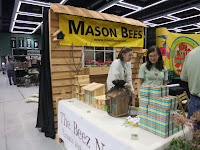 |
| Here is Jim Tunnel(with cap), owner of Beez Neez explaining mason bees to 3 customers. |

 We are at the Beez Neez booth. Go to Row 2200 and you will find us with a bright yellow MASON BEE banner. See you at the show.
We are at the Beez Neez booth. Go to Row 2200 and you will find us with a bright yellow MASON BEE banner. See you at the show.
This blog is about cool things people tell me about, the things I see and photo-ops during my travels. My interest is related to bees and pollination, in particular mason bees and their management. Search a subject by using the search bar below.
 |
| Royal house with predator guard |
 |
| Temporarily remove predator guard from the front of the Royal house, and set vial on its side, with tab removed, underneath peaked roof. Replace predator guard. |
 |
| Lodge without predator guard. |
 |
| Chalet with predator guard. |
 |
| If you have a Starter Cottage with cardboard tubes it is best to set the vial of cocoons inside the cottage amongst the nesting tubes. |
 |
| Temporarily remove front door to access cardboard tubes. |
 |
| Remove a few cardboard tube to make room for one vial containing mason bee cocoons. Remove red tab covering the exit hole of the vial, and place vial amongst tubes. |
 |
| Retail stores sell Beediverse mason bee cocoons in snap-cap vials. Cocoons were harvested from nesting tunnels and cleaned. |
 |
| Loose cocoons harvested from nesting tunnels can also be placed underneath the roof of the Highrise-"the attic" |
 |
| Move cocoons towards the back. of the Highrise so they dont roll out the exit gap. |
 |
| Drop roof over attic in readiness for spring. |
 |
| Dave M.'s emergence box with nests on either side. Emerged males are clustered on the outside of the emergence box waiting for females to emerge. |
 |
| This honey bee (left hand side) and mason bee are too busy feeding on a dandelion flower to notice the photographer Dave M. Port Alberni, BC. |
"When you see them up close they have an incredible amount of pollen on their back legs. The opening into the bird house is 1 1/4" so you can see how huge they are."
Underneath the moss is a bumble bee colony. One bumble bee guard is walking on the surface of the colony.
 |
| This is a guard- watching out for predators. |
 |
| Bumble bee on the left is cooling the colony with its wings. The bumble bee on the right seems to be ready to go and gather more pollen and nectar for the young bees. |
 |
| Coming in for landing. |
 |
| Resting after a long flight. |
 |
| Making room for a larger colony by removing excess moss material. |
 |
| Summer mason bees removed from their Quicklock-Corn nesting tunnels. This bee uses masticated leaf material as partition material. |
 |
| Summer solitary bees in a wooden nesting tray. |
 |
| Beediverse Emergence Shelter |
 |
| Emergence nesting boxes made by Dave M. of Port Alberni BC. |
 |
| Summer mason bee cocoons placed into a Emergence/Release box, after removal from nesting trays. |
 |
| Scoop tool |
 |
| Cocoons are scooped out of nesting trays straight into a large bucket filled with water. |
 |
| A soft stream of water washes a lot of debris from cocoons held in a sieve. This idea came from Dave M. from Port Alberni, BC |
 |
| Small and large release box with piano hinged lids |
 |
| Small release box with simple lid. Plastic containers are good for interim storage, but predation dictates a more sturdy wooden box. |